Connect dummy rail pressure regulator after disconnecting rail pressure regulator connector.
Refer to "CRT-1000 Tester composition" of detail inspections (Equipment settings).
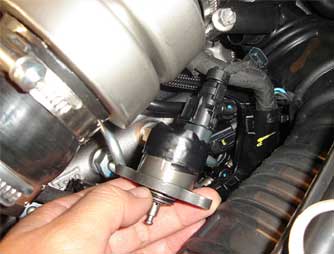
To remove high pressure fuel system, Never perform any work engine running or within 60 seconds after the engine stops. It is recommended to wear safety glasses. Ensure the absolute cleanliness to prevent an inrush of foreign substances in high pressure fuel system.
Perform Inspect as below to check high pressure fuel system because impossible starting, engine stalls and poor power (acceleration) could be caused by abnormal high pressure fuel system.
IG KEY "OFF", ENGINE "OFF"
Connect dummy rail pressure regulator after disconnecting rail pressure regulator connector.
Refer to "CRT-1000 Tester composition" of detail inspections (Equipment settings).

Connect the PRV Control Cable (CRT - 1044) to rail pressure regulator.
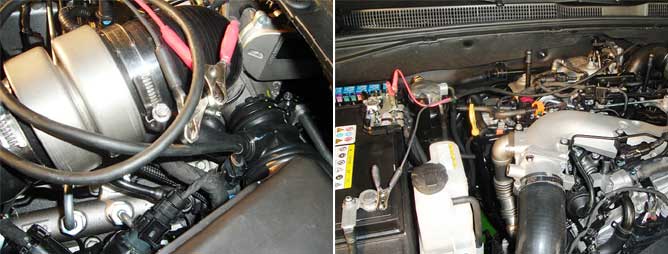
Connect the regulator valve (CRT - 1020) to common rail (Bank2 side) after removing rail to rail high pressure tube.
☞ Cap the dust cap (CRT - 1035) to nipple of common rail (Bank1 side) to prevent foreign substances from getting in.
☞ For removing high pressure tubes, Use the SST (09314 - 3A000).
Cap the plug (for Bosch) M12mm to common rail (Bank2 side) after removing rail to injector high pressure tube (#2,4,6).
☞ Cap the dust cap (CRT - 1035) to nipple of injector (#2,4,6) to prevent foreign substances from getting in.
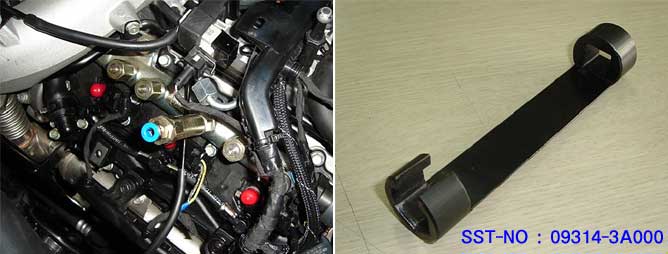
Install connection tube (CRT - 1052) and low pressure gauge (CRT - 1051) to return nipple on the common rail (Bank 2 side).
☞ Install visible tube (CRT - 1031) to check high pressure fuel leakage from common rail.
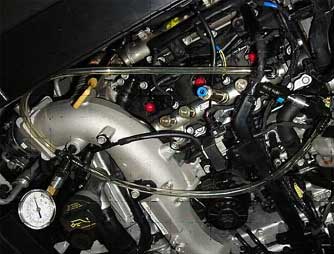
Install flask & holder (CRT - 1030) to regulator valve (CRT - 1020) nipple by using visible tube.
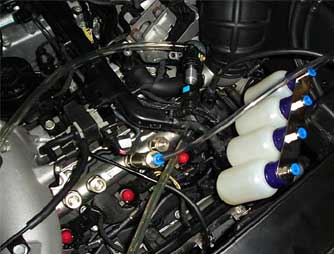
Remove all injector connectors to prevent engine from starting.
Connect (+),(-) terminal of PRV control cable to battery (+), (-) terminal.
Inspect that high pressure pump makes high pressure well and check high pressure fuel leakage from rail pressure regulator.
☞ Pressure in the common rail is increased over 1,200 bar within 3 ~ 5 seconds after cranking.
- If pressure in the common rail is increased over pressure limit ( approx 1,200 bar), fuel is discharged to flask (CRT - 1030) through visible tube.
- If an inflow of fuel quantity to flask is enough and pressure of common rail is increased well over 1,200 bar, performance of high pressure is good.
☞ Low fuel pressure must keep 4.6 ~ 5.2 bar in the test.
☞ There should be no fuel leakage from return hose of rail pressure regulator.
☞ After testing, If power of rail pressure regulator is cut, pressure of common rail is released through rail pressure regulator. (Inspector can see discharged fuel through return hose.)
Symptom | Inspection procedure | |
Case1 | ● Pressure of high pressure fuel system is normal.[Fuel is discharged through nipple of regulator valve (CRT - 1020) within 3 ~ 5 seconds and fuel discharged is enough.] | ● High pressure pump and rail pressure regulator are normal. After connecting rail to injector tube to each cylinder, If rail pressure is not increased, poor acceleration and engine stall occurs with DTC (related to rail pressure). ☞ Replace the injector (injector is not sealed at high pressure.) |
Case2 | ● Fuel is NOT discharged through nipple of regulator valve (CRT - 1020) with long cranking (over 5 seconds). (Fuel is discharged through return nipple of rail pressure regulator.) | ● Rail pressure is leaked because rail pressure regulator is NOT sealed. ☞ Replace rail pressure regulator (Bank2 assembly). |
Case3 | ● Fuel is NOT discharged through nipple of regulator valve (CRT - 1020) with long cranking (over 5 seconds). [Fuel is NOT discharged through return nipple of rail pressure regulator but rail pressure is NOT increased to limit pressure (approx 1,200 bar).] | ● Performance of the high pressure pump is NOT good. ☞ Replace the high pressure pump assembly. |